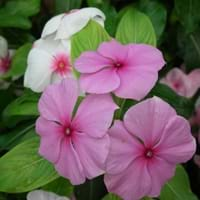Life Span
Perennial
Perennial
Type
Perennial
Flowering Plants, Shrubs
Origin
Hybrid origin
Madagascar
Types
Aristocrat, Buckeye Belle, Henry Bockstoce , Abalone Pearl, Coral Supreme, Cytherea, Charlie's White
Purple vinca, Vinca, cherry red, strawberry color
Habitat
Hillside, Woods
Subtropical climates, Tropical regions
USDA Hardiness Zone
Not Available
4-9
Sunset Zone
Not Available
A1, A2, A3, H1, H2, 1a, 1b, 2a, 2b, 3a, 3b, 4, 5, 6, 7, 8, 9, 10, 11, 12, 13, 14, 15, 16, 17, 18, 19, 20, 21, 22, 23, 24
Habit
Clump-Forming
Clump-Forming
Flower Color
Not Available
Magenta, Pink, Rose
Flower Color Modifier
Bicolor
Not Available
Fruit Color
Not Available
Not Available
Leaf Color in Spring
Not Available
Dark Green
Leaf Color in Summer
Not Available
Dark Green
Leaf Color in Fall
Not Available
Dark Green
Leaf Color in Winter
Light Green
Dark Green
Plant Season
Spring, Summer
Fall, Spring, Summer, Winter
Sunlight
Full Sun, Partial Sun, Partial shade
Partial shade
Type of Soil
Clay, Loam
Loamy, Sandy, Well drained
The pH of Soil
Acidic, Neutral, Alkaline
Neutral, Slightly Alkaline
Soil Drainage
Average
Well drained
Bloom Time
Not Available
Fall, Spring, Summer
Tolerances
Drought
Drought, Pollution, Salt
Where to Plant?
Ground, Pot
Container, Ground, Pot
How to Plant?
Grafting, Seedlings, Stem Planting, Transplanting
Seedlings, Stem Planting, Transplanting
Plant Maintenance
Medium
Medium
Watering Requirements
Does not require lot of watering, It cannot sustain wet-feet, Keep the ground moist but not water-logged, Needs watering once a week, Prefer drip-irrigation instead of Over-head watering, Water occasionally
Does not require lot of watering, Medium
In Summer
Lots of watering
Lots of watering
In Spring
Moderate
Moderate
In Winter
Average Water
Average Water
Soil pH
Acidic, Neutral, Alkaline
Neutral, Slightly Alkaline
Soil Type
Clay, Loam
Loamy, Sandy, Well drained
Soil Drainage Capacity
Average
Well drained
Sun Exposure
Full Sun, Partial Sun, Partial shade
Partial shade
Pruning
Do not prune during shooting season, Prune to control growth, Remove dead or diseased plant parts, Remove deadheads
Prune ocassionally
Fertilizers
All-Purpose Liquid Fertilizer
All-Purpose Liquid Fertilizer
Pests and Diseases
Botrytis Blight, Leaf spot, Stem spot, Viruses
Botrytis Blight, Canker, Crown rot, Pythium rot, Root rot
Plant Tolerance
Drought
Drought
Flower Petal Number
Not Available
Single
Foliage Texture
Not Available
Medium
Foliage Sheen
Not Available
Glossy
Attracts
Ants
Butterflies
Allergy
Not Available
Intestinal gas, Nausea, Vomiting
Aesthetic Uses
Beautification, Bouquets, Showy Purposes, Used for decorating walls, fences, gates, hedges, etc.
Beautification, Showy Purposes
Beauty Benefits
Not Available
Not Available
Environmental Uses
Air purification
Air purification
Medicinal Uses
Cough, Gout, Headache, Heartburn, Kidney problems, Upset stomach, Urinary tract problems
Chest pain, High blood pressure, Inflammation, Sore throat, Tooth ache, Wounds
Part of Plant Used
Flowers, Root, Seeds
Whole plant
Other Uses
Showy Purposes, Used as Ornamental plant, Used for fragrance
Decoration Purposes, Showy Purposes, Used as Ornamental plant
Used As Indoor Plant
No
Yes
Used As Outdoor Plant
Yes
Yes
Garden Design
Cutflower, Feature Plant, Foundation, Mixed Border
Bedding Plant, Container, Edging
Botanical Name
PAEONIA 'Rachel'
Catharanthus roseus
Common Name
Intersectional Peony
Madagascar periwinkle or rosy periwinkle
In Hindi
Intersectional Peony
Periwinkle
In German
Intersectional Pfingstrose
Immergrün
In French
intersectionnelle Pivoine
Pervenche
In Spanish
interseccional Peony
Bígaro
In Greek
διατομεακές Παιώνια
μυρτιά
In Portuguese
interseccional Peony
Mirta
In Polish
międzysegmentowe Piwonia
Barwinek
In Latin
Intersectional AGLAOPHOTIS
Periwinkle
Phylum
Tracheophyta
Mollusca
Class
Magnoliopsida
Gastropoda
Order
Saxifragales
Geraniales
Family
Paeoniaceae
Apocynaceae
Genus
Paeonia
Catharanthus
Clade
Angiosperms, Core eudicots, Eudicots
Not Available
Tribe
Not Available
Not Available
Subfamily
Not Available
Not Available
Season and Care of Intersectional Peony and Periwinkle
Season and care of Intersectional Peony and Periwinkle is important to know. While considering everything about Intersectional Peony and Periwinkle Care, growing season is an essential factor. Intersectional Peony season is Spring and Summer and Periwinkle season is Spring and Summer. The type of soil for Intersectional Peony is Clay, Loam and for Periwinkle is Loamy, Sandy, Well drained while the PH of soil for Intersectional Peony is Acidic, Neutral, Alkaline and for Periwinkle is Neutral, Slightly Alkaline.
Intersectional Peony and Periwinkle Physical Information
Intersectional Peony and Periwinkle physical information is very important for comparison. Intersectional Peony height is 71.10 cm and width 60.00 cm whereas Periwinkle height is 1.97 cm and width 2.96 cm. The color specification of Intersectional Peony and Periwinkle are as follows:
Intersectional Peony flower color: Not Available
Intersectional Peony leaf color: Not Available
Periwinkle flower color: Magenta, Pink and Rose
- Periwinkle leaf color: Dark Green
Care of Intersectional Peony and Periwinkle
Care of Intersectional Peony and Periwinkle include pruning, fertilizers, watering etc. Intersectional Peony pruning is done Do not prune during shooting season, Prune to control growth, Remove dead or diseased plant parts and Remove deadheads and Periwinkle pruning is done Prune ocassionally. In summer Intersectional Peony needs Lots of watering and in winter, it needs Average Water. Whereas, in summer Periwinkle needs Lots of watering and in winter, it needs Average Water.





